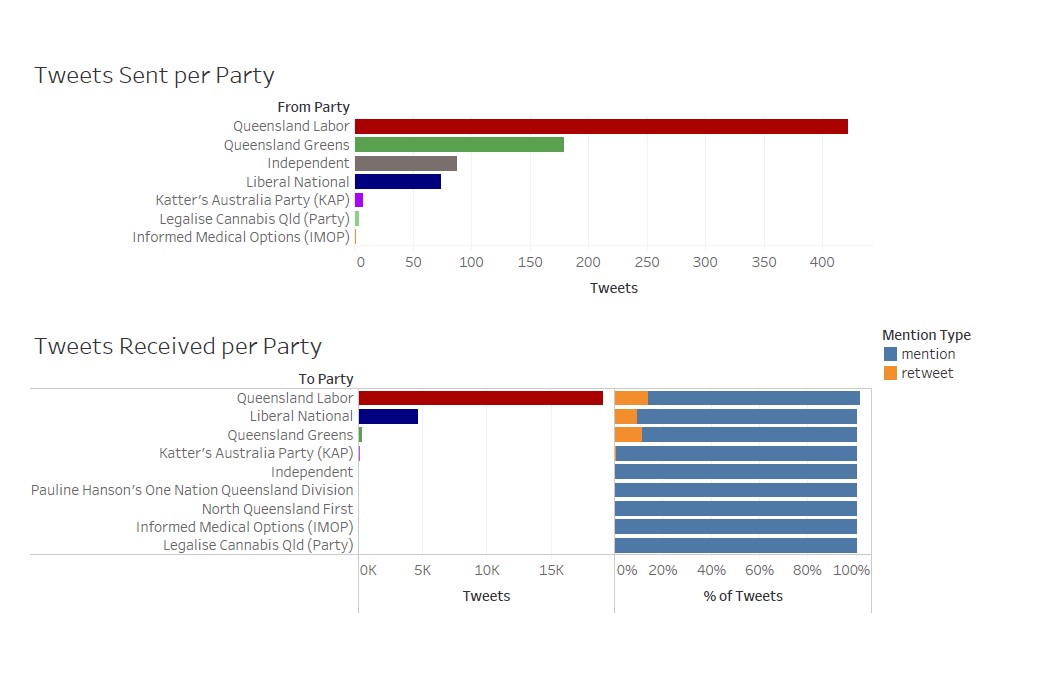
Social media has forever changed political campaigns, with stump speeches and doorknocking increasingly complemented by bite-sized tweets, but one political party is ahead of the others as the Queensland election approaches.
With Queenslanders set to go to the polls on 31 October, researchers from QUT’s Digital Media Research Centre (DMRC) are tracking the action on social media platforms. What they have found so far indicates the LNP is well behind Labor, The Greens and many of the Independents, at least on its Twitter performance.
Another key finding shows very limited use of bots interfering to generate false messages or smear campaigns.
“We have so far identified 132 election candidates with Twitter accounts, including 57 Labor candidates, 29 from the Liberal-National Party, 13 from the Queensland Greens, 10 from One Nation, and 23 minor party candidates and Independents,” said Professor Bruns.
 “Many more are on Facebook: of the 311 Facebook pages we have found, 82 belong to Labor, 80 to the LNP, 42 each to the Greens and One Nation, and 65 to minor party and Independent candidates.
“Many more are on Facebook: of the 311 Facebook pages we have found, 82 belong to Labor, 80 to the LNP, 42 each to the Greens and One Nation, and 65 to minor party and Independent candidates.
“The 2020 Queensland state election takes place in the shadow of COVID-19, which poses new and unprecedented challenges for the campaigners.
“Many voters are also opting for early in-person or postal voting to avoid potentially unsafe crowds at booths on the day. As a result, the reach on social media will be critical for politicians and we can already see it will play a greater role than in previous state and federal elections.”
Along with Professor Bruns, the DMRC team includes Associate Professor Dan Angus and Dr Tim Graham. They will analyse the patterns of activity on social media during the state election campaign, with particular focus Facebook and Twitter.
“Our first report on Twitter covers the period of 3-8 October. During these early days of the campaign, Labor and Greens candidates were the most active on the platform, followed by their Independent challengers; LNP candidates have tweeted relatively little so far.
“Perhaps as a result, but possibly also because of the substantial attention paid especially to Premier Annastacia Palaszczuk and Health Minister Steven Miles as key decision-makers on pandemic mitigation policy, Labor candidates have received the lion’s share of mentions and retweets so far. In that timeframe we identified some 19,000 tweets addressing Labor candidates, compared to only 4,700 for LNP politicians.”
Associate Professor Dan Angus said the Premier led both lists, with 88 tweets sent during this period, and 12,000 received. By contrast, Opposition Leader Deb Frecklington sent 8 tweets and received some 4,000 mentions and retweets.
“State Health Minister and Deputy Premier Steven Miles also receives very substantial Twitter engagement, almost certainly due to his key role in managing the current crisis. At 5,800 tweets received (4% of them retweets), he is the other Labor politician to be tweeted at more than Ms Frecklington,” he said.
“Looking more widely at the issues and topics raised on Twitter throughout the entire week, we found Labor were strongly challenged around what some see as an each-way bet on the coal and fossil fuel industry.
“Other topics that generated significant discussion included the ongoing NSW/Queensland border restrictions, while the ghost of former LNP Premier Campbell Newman made an appearance in the context of warnings of cuts to frontline public service staff by Deb Frecklington, with a particular emphasis on health workers.
“There was also discussion centred around key policy announcements such as investments in construction projects by Labor and the LNP, and in Bruce Highway upgrades by the LNP.”
Dr Graham used the Botometer tool, which calculates the likelihood an account is automated, and an analysis of the top 500 most active accounts related to the Queensland election (by tweet volume) found one likely bot account.
“That is good news as it means bots are not running riot during #QLDVotes, at least for now. It could easily ramp up as we have seen in election lead-ups elsewhere in Australia and overseas,” said Dr Graham.
Professor Bruns said candidates and parties themselves mostly focused on their own announcements.
“Labor highlighted plans for economic stimulus and job creation beyond the pandemic and attacked the LNP over their record on cuts to essential services, while the LNP focussed on their own investments in construction and were involved in minor skirmishes with select Labor candidates,” said Professor Bruns.
“The Greens, meanwhile, used the platform to champion their policy of using mining royalties to fund new social services in the education, health and welfare sectors.”
Media contact:
Amanda Weaver, QUT Media, 07 3138 3151, amanda.weaver@qut.edu.au
After hours: Rose Trapnell, 0407 585 901, media@qut.edu.au


